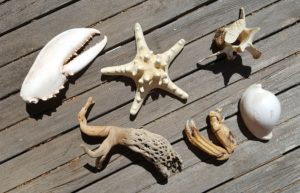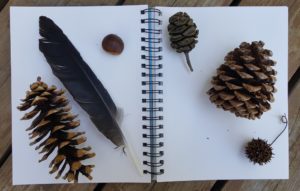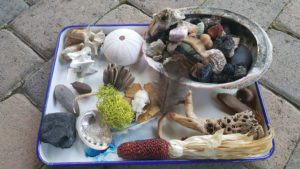A common obstacle to getting started on a nature sketching practice is not knowing what to draw, or not having anything around the house interesting enough to inspire you to get out your art supplies. So, I’m challenging you to find interesting things around your house to draw and to assemble a small cabinet of curiosities (more on that below.)
I want to help you make it as convenient as possible to sketch at a moment’s notice and without hesitation by giving you a bunch of creative ideas, so you’ll never be able to use that excuse “ I don’t know what to draw” ever again!
For today’s challenge, I’d like to focus on things you can have on hand in your home, so you’ll have a ready stash whenever the urge to sketch strikes and for days when time and weather aren’t on your side. Later we’ll explore what to sketch when you’re in the great outdoors.
Assembling your cabinet of curiosities
I encourage you to assemble a small cabinet of curiosities – a concept that originated in Victorian England for natural history collections of the well-traveled elite. Whether your items end up filling a whole cabinet, or simply a shoe box, searching for them could be a fun family activity. Don’t overlook very small things for your collection; you can appreciate their intricate details using a child’s magnifying lens.
Ideas for your cabinet of curiosities
Scour your house, closets, and garage (or garage sales) for items like those below.
- Seashells
- Crystals, rocks, and fossils
- Dried flowers, leaves, and seedpods
- Bones and feathers
- Additional exotic items as described in my cabinet of curiosities
What to do if I don’t have any of the above items?
If you are short on things to draw at home, keep your eyes peeled for things to collect (don’t forget a small bag or box) next time you go on a vacation or a hike.
You can also purchase preserved and living specimens to sketch from biological supply companies such as Carolina Biological Supply or Nasco. Craft supply stores, such as Michael’s, Joann, Ben Franklin Crafts or Hobby Lobby often have interesting things you might purchase for your collection, like cones, seashells, decorative seed pods and artificial flowers (don’t knock it, even Georgia O’Keeffe used these for her flower and skull drawings.)
Things to consider if you collect items from nature
I hope this goes without saying, but I will: please don’t collect living animals or dig up plants and be mindful of any laws against collecting or permits that may be required to do so. Use good judgment from your own code of ethics when it comes to what to collect and how much. For example, if you want to pick a flower to press and preserve, make sure it isn’t a threatened species and that there are many others blooming to take its place. And if you plan to buy any natural history objects, make sure to inquire about how they were obtained, ie: in a legal and ethical manner.
Additional things you might try sketching around your home:
- Your pets (or buy a new one from a pet store; even a simple cricket or goldfish will do).
- Insects around the home (put in a glass jar to observe).
- Houseplants and floral bouquets.
- Fruits and vegetables from the kitchen.
- Photographs cut out of magazines.
- Kid’s animal toys (I still sketch my Breyer Horse model kept from childhood!).
Today’s challenge
- Gather items for your ‘cabinet of curiosities’ and display them somewhere, say in a bowl, shoebox or on a bookshelf. The key is that they must be easily viewed and convenient to reach for your sketching inspiration. In addition to the ideas above, you may get more by reading the story of the cabinet of curiosities I’ve assembled over the years.
- Choose one or more items and spend 10 minutes observing and sketching them.
- Post a description or photo of your collection on our Facebook page.
Click here to return to Nature Sketching Challenge home page
Show Your Support
If you are finding value in the lessons from this Nature Sketching Challenge, I invite you to consider donating funds to support me in the creation and ongoing improvement of this program. Even the smallest donation helps me to know that I’m providing lessons that inspire, entertain and educate you about the natural world.
Click the Paypal ‘Donate’ button below to donate any amount you wish. You do not need to have a Paypal account to donate, you may choose to use a credit card if you wish. Thank you!





